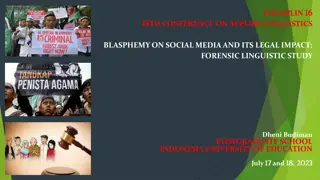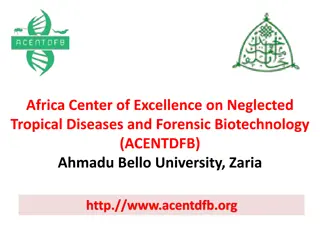Forensic Biology Data Interpretation Committee Overview
The Biological Data Interpretation and Reporting Committee focuses on establishing best practices, guidelines, and standards for forensic DNA laboratory interpretation. Their goal is to ensure quality and consistency in the forensic community by standardizing scientifically valid methods of interpretation, statistical analysis, and reporting of biological results.
Download Presentation

Please find below an Image/Link to download the presentation.
The content on the website is provided AS IS for your information and personal use only. It may not be sold, licensed, or shared on other websites without obtaining consent from the author. Download presentation by click this link. If you encounter any issues during the download, it is possible that the publisher has removed the file from their server.
E N D
Presentation Transcript
Priority Action Report Biology Biology Data Interpretation and Reporting Committee Mechthild Prinz February 22, 2016
Subcommittee Leadership Position Name Organization Term Email Chair Robyn Ragsdale, Ph.D. FDLE 4 robynragsdale@fdle.state.fl. us Vice Chair Mechthild Prinz, Ph.D. John Jay College of Criminal Justice 2 mprinz@jj.cuny.edu Executive Secretary Catherine Grgicak, Ph.D. Boston University School of Medicine 3 cgrgicak@bu.edu 2
# Name Organization Term Email Subcommittee Members Lisa Marie Brewer Glendale Police Department Todd Bille ATF 3 todd.bille@atf.gov 1 3 lbrewer@glendaleca.gov 2 Michael Coble, Ph.D. NIST 4 mcoble@nist.gov 3 Kathleen Corrado, Ph.D. Onondaga County Center for Forensic Sciences 2 kcorrado@ongov.net 4 Julie French GE Health Care 4 julie.french@ge.com 5 Bill Gartside San Bernardino County Sheriff's 3 bgartside@sbcsd.org 6 Rebekah J. Kay Utah Bureau of Forensic Services 4 rkay@utah.gov 7 Susannah C. Kehl FBI 2 susannah.kehl@ic.fbi.gov 8 Shawn Montpetit San Diego Police Department 3 smontpetit@pd.sandiego.gov 9 Steven Myers California Department of Justice Jan Bashinski DNA Laboratory 3 Steven.Myers@doj.ca.gov 10 Jeff Nye Michigan State Police 2 nyej1@michigan.gov 11 Peg (Margaret) Schwartz, Ph.D. Vermont Forensic Laboratory (retired) 2 mbschwartzvt@gmail.com 12 Carl Sobieralski Indiana State Police Laboratory Department 4 csobieralski@isp.in.gov 13 Joel Sutton DFSC -USACIL 2 joel.d.sutton2.civ@mail.mil 14 Christian G. Westring, Ph.D. NMS Labs 3 christian.westring@NMSlabs.com 15 Charlotte J. Word, Ph.D. Self Employed as a Private Consultant 3 cjword@comcast.net 16 Sandy Zabell, Ph.D. Northwestern University, Department of Mathematics 4 zabell@math.northwestern.edu 17 3
Affiliates Name Organization/Employer Task Group Dr. Michael Adamowicz University of New Haven Probabilistic Genotyping Dr. James Curran University of Auckland, NZ Probabilistic Genotyping Dr. Adele Mitchell Merck Probabilistic Genotyping Mark Powell San Francisco Police Department Crime Lab Probabilistic Genotyping Dr. Charles Brenner Self Software Validation Malena Jimenez STACS DNA Software Validation Dr. Desmond Lum Rutgers University Software Validation Jessica Charak Las Vegas Metropolitan Police Department Mixture Interpretation Kristen Fripp Georgia Bureau of Investigation Mixture Interpretation Marla Kaplan Oregon State Police Mixture Interpretation Beth Ordeman Pinellas County Forensic Laboratory Mixture Interpretation 4
Biological Data Interpretation and Reporting Committee This Subcommittee (formerly called DNA Analysis 2) will focus on standards and guidelines related to forensic DNA laboratory interpretation. The Biological Data Interpretation Committee will focus on establishing best practices, guidelines, and standards for inclusion in the OSAC Registry. The goal is to foster quality and consistency within the forensic community through the standardization of scientifically valid methods of interpretation, statistical analysis and reporting of biological results. 5
Summary of Standards/Guidelines Priority Actions Priority Working Title of Document 1 Validation Standards for Probabilistic Genotyping Systems 2 Standards for Validation Studies of DNA Mixtures and the Development and Verification of a Laboratory s Mixture Interpretation Protocol 3 Biology/DNA Software Validation 4 Statistical Interpretation 6
Standards/Guidelines Development Priority 1 Document Document Title: Validation Standards for Probabilistic Genotyping Scope: These standards are to be used by laboratories for the validation of probabilistic genotyping systems related to interpreting autosomal STR results. Objective/rationale: If a laboratory wishes to use probabilistic genotyping in interpreting their casework, it must first be appropriately validated as with any new method prior to use. No standards currently exist for laboratories validating and implementing probabilistic genotyping systems. Issues/Concerns: No standards currently exist for laboratories validating and implementing probabilistic genotyping systems. Task Group Name: Probabilistic Genotyping Task Group Chair Name: Joel Sutton Task Group Chair Contact Information: joel.d.sutton2.civ@mail.mil Date of Last Task Group Meeting: 28 Jan 2015 7
Standards/Guidelines Development Priority 1 Document Key Components of Standard: Developmental validation studies needed Internal validation studies needed Sample types to be run with each validation study Underlying scientific principles for the method need to be published in a peer-reviewed journal for reference Software modification considerations 8
Priority 1: Validation Standards for Probabilistic Genotyping Task Group/Subcommittee Action Plan OSAC Process Stage (e.g., SDO 100) Estimated Completion Date Planned Actions Assignee Review SAC comments and adjudicate SDO-300 Task Group 04 Feb 2016 Post to Kavi for BDIRC to review and vote on changes SDO-300 Task Group Chair 11 Feb 2016 Submit to SAC for vote SDO-300 BDIRC Chair ? 9
Standards/Guidelines Development Priority 2 Document Document Title: Standards for Validation Studies of DNA Mixtures and the Development and Verification of a Laboratory s Mixture Interpretation Protocol Scope: These standards are for the design and evaluation of validation studies for mixed DNA samples and the development of appropriate interpretation protocols for mixtures based on the validation studies performed. Objective/rationale: Determine standards to allow for verification of a laboratory s mixture interpretation protocol Issues/Concerns: No existing standards Task Group Name: Mixture Interpretation Verification Task Group Chair Name: Carl Sobieralski/Shawn Montpetit Task Group Chair Contact Information: csobieralski@isp.in.gov / smontpetit@pd.sandiego.gov Date of Last Task Group Meeting: 01/29/2016 10
Standards/Guidelines Development Priority 2: Standards for Validation Studies of DNA Mixtures and the Development and Verification of a Laboratory s Mixture Interpretation Protocol Key Components of Standard: The laboratory shall only interpret mixed DNA data for which there are supporting internal validation studies and data, supporting publications when available, and relevant and appropriate interpretation protocols in the laboratory. The mixture studies performed as part of internal validation studies will include representative samples of those to be interpreted in casework The data from mixture studies performed by the laboratory shall be evaluated and summarized The laboratory shall verify and document that the mixture interpretation protocols developed from the validation studies generate reliable and consistent interpretations and conclusions for the types of mixed DNA samples typically encountered by the laboratory 11
Priority 2: Standards for Validation Studies of DNA Mixtures and the Development and Verification of a Laboratory s Mixture Interpretation Protocol Task Group/Subcommittee Action Plan OSAC Process Stage (e.g., SDO 100) Estimated Completion Date Planned Actions Assignee Fill in required forms. Initiate project. SDO-0 Task Group 01/29/2016 Move draft document to next level (BDRIC, Methods SC, RC, SAC) SDO- 200/SDO- 300 Task Group 02/05/2016 12
Standards/Guidelines Development Priority 3 Document Document Title: Biology/DNA Software Validation Scope: This document includes guidelines for the validation of software used in a forensic DNA laboratory that impacts the integrity of the evidence, the analytical process, interpretations and/or statistical conclusions. Additional guidelines and standards may be applicable to specialized software packages. Objective/rationale: Few standards are available for the validation of software used by a forensic DNA laboratory. Issues/Concerns: Newly developed or modified software programs should be validated prior to implementation. Task Group Name: Biology/DNA Software Validation Task Group Chair Name: Susannah Kehl Task Group Chair Contact Information: susannah.kehl@ic.fbi.gov Date of Last Task Group Meeting: Jan 29, 2016 13
Standards/Guidelines Development Priority 3 Document: Bio/DNA Software Validation Key Components of Standard: The goal is to provide standards or guidelines for the validation of software used by forensic laboratories when conducting forensic DNA testing. Establish standards or guidelines for the validation of software programs and upgrades that impact the integrity of the evidence, the analytical process, interpretation and/or conclusions. 14
Priority 3: Bio/DNA Software Validation Task Group/Subcommittee Action Plan OSAC Process Stage (e.g., SDO 100) Estimated Completion Date Planned Actions Assignee Provide draft document to relevant subcommittees for input, revise as appropriate SDO-0 Susannah Kehl March 1, 2016 Provide draft document to resource committees and SAC for input, revise as appropriate SDO-0 Susannah Kehl May 1, 2016 Create Project and fill in required forms SDO-0 Task Group Jan 29, 2016 Submit SDO Submission Form SDO-100 Susannah Kehl Jan 29, 2016 Move draft document to next level SDO-200/300 Task Group June 1, 2016 15
Standards/Guidelines Development Priority 4 Document Document Title: Statistical Interpretation Scope: Description of existing methods and delineating appropriate areas of application Objective/rationale: State generally accepted methods and limitations for statistical analysis of single source and mixed DNA profiles Issues/Concerns: Concerns have been raised about the correct application of different statistical approaches used in the interpretation of mixtures. Task Group Name: Statistical Interpretation Task Group Chair Name: Sandy Zabell Task Group Chair Contact Information: zabell@math.northwestern.edu Date of Last Task Group Meeting: January 28, 2016 16
Standards/Guidelines Development Priority 4 Document Key Components of Standard: Description of existing methods, and guidance on appropriate areas of application Note: Our understanding is that SWGDAM will very shortly release for comment a substantial revision of its 2010 SWGDAM Interpretation Guidelines for Autosomal STR Typing by Forensic DNA Testing Laboratories . The work of the Task Group has been temporarily suspended until this document is available for review to avoid duplication of effort. 17
Priority 4: Statistical Interpretation Task Group/Subcommittee Action Plan OSAC Process Stage (e.g., SDO 100) Estimated Completion Date Planned Actions Assignee Review of documents SDO 100 Dr. Zabell May 1, 2016 Drafting of standard SDO 100 Members of TG October 1, 2016 18
Standards/Guidelines Development Priority 5 Document Review and standardization of terminology within the field using current documentation. Being performed in conjunction with other Biology subcommittees Task Group Name: Terminology Task Group Chair Name: Christian Westring, Ph.D. Task Group Chair Contact Information: christian.westring@NMSlabs.com 19
Priority 5: Terminology Task Group/Subcommittee Action Plan SAC level task group encompassing all of the DNA subcommittees Working on collating terms used in forensic biology analysis 20
Summary of Standards/Guidelines Priority Actions Priority Working Title of Document 1 Validation Standards for Probabilistic Genotyping Systems 2 Standards for Validation Studies of DNA Mixtures and the Development and Verification of a Laboratory s Mixture Interpretation Protocol 3 Biology/DNA Software Validation 4 Statistical Interpretation 5 Terminology (SAC wide task group) 21
Items of Interest Identified Analytical and stochastic thresholds guidance on valid approaches on how to determine these thresholds Front end evaluation of DNA profile data guidance on determining suitability for various interpretation approaches Hypothesis building for LRs guidance on assumptions, numerator, denominator Monitoring analysts performance for DNA interpretation guidance on internal assessment of interpretation competency including statistical evaluations Reporting of DNA conclusions for mixtures standard defining required components 22
Research Gaps Identified - 1 (in order of evidence analysis process) More efficient collection of DNA at the scene and from evidence items Quantitative interpretation of color signals for serology testing results More efficient extraction of DNA from evidence items Assessment of specific classes of evidence types to determine the necessity to quantify DNA before amplification 23
Research Gaps Identified - 2 (in order of evidence analysis process) Develop software to tools to assist in characterization and utilization of STR typing validation data Software solutions for Y-STR mixture deconvolution Research on how to design proficiency tests for complex data interpretation and probabilistic genotyping Impacts of laboratory, assumptions, and model decisions on continuous likelihood ratios Best practices to avoid biases in interpretation of DNA profiles 24
Priority Action Report Biology Biology Data Interpretation and Reporting Committee Mechthild Prinz February 22, 2016























